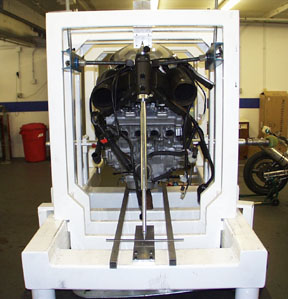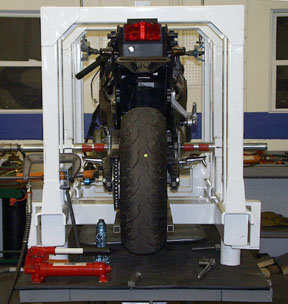Once a chassis has been measured, it may need to be
aligned. This step is very important in both crash repair and handling optimization.
A chassis that is not square and true has the suspension planes and axis
skewed relative to the swing arm pivot axis, thus setting up a scissor type motion
of the suspension as viewed from the back. The chassis then "winds up" or
rotates as viewed form the top. This twisted suspension motion sets off problems such as
head shakes, pulling one side, turning better to one side or the other, and for
racers a straight chassis grips better and is more predictable to ride at the
limit.

|
 The
greater the suspension travel, the more critical
the alignment is to good handling. This makes
alignment of off-road bikes even more critical as
the long suspension travel makes them more
susceptible to swapping, due to the increased
lateral displacement. To correct a twisted frame
or swing arm, the chassis is loaded in a
correction jig and held tight. Braces are placed
around the chassis and jack screws and hydraulic
rams are used to draw the chassis into alignment.
Incases of severe misalignment, heat may be used
to relax aluminum or stress relieve steel. The
greater the suspension travel, the more critical
the alignment is to good handling. This makes
alignment of off-road bikes even more critical as
the long suspension travel makes them more
susceptible to swapping, due to the increased
lateral displacement. To correct a twisted frame
or swing arm, the chassis is loaded in a
correction jig and held tight. Braces are placed
around the chassis and jack screws and hydraulic
rams are used to draw the chassis into alignment.
Incases of severe misalignment, heat may be used
to relax aluminum or stress relieve steel.
|